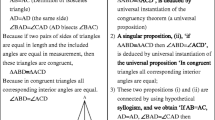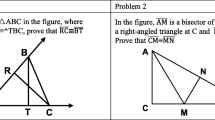Abstract
This chapter reports a case study of an experienced and competent mathematics teacher teaching Angle Properties of Circles to a class of Secondary Three students in the Express course of study. Geometry in the school curriculum serves as a good platform for inducting students into the rigour of mathematical thinking through deductive reasoning, and the world of deductive mathematical arguments in the form of mathematical proof, which forms the common language of mathematicians worldwide. It is this rigour and discipline that students usually encounter much difficulty with. Quite contrary to our stereotyped image of a traditional geometry lesson, the teacher used a variety of approaches to enrich the lesson. She used a series of scaffoldings to lead the students from inductive exploration through discovery activities to deductive reasoning and the formalism of writing of reasoning in geometry, juggling between her belief on the importance of discovery learning and the curriculum requirement of deductive reasoning in geometry. It was interesting to us that the teacher, in transiting from students’ exploration to identifying the geometric properties, made use of rich visual imagery related to circle properties to develop in her students the concept images associated with the geometry property. Through the use of visuals to facilitate her students’ learning, effort was made to ensure her students truly understood the geometrical properties and used the properties in working with problems. Deductive reasoning was introduced in the lesson closure portion of the lesson to stress the interconnectedness across the various geometrical properties. The stages that the teacher went through in guiding the students from the intuitive-experimental stage to the deductive reasoning resonates with the van Hiele levels of students’ learning of geometry. The teacher highlighted during the interview about her conscious attempt to achieve a balance between an intuitive-experimental approach to facilitate her students’ learning and maintaining mathematical rigour that is required of the geometry strand in the Singapore school mathematics curriculum.
Access this chapter
Tax calculation will be finalised at checkout
Purchases are for personal use only
Similar content being viewed by others
References
Ayalon, M., & Even, R. (2010). Mathematics educators’ views on the role of mathematics learning in developing deductive reasoning. International Journal of Science and Mathematics Education,8(6), 1131–1154.
Clarke, D. J. (1998). Studying the classroom negotiation of meaning: Complementary accounts methodology. Chapter 7 in A. Teppo (Ed.), Qualitative research methods in mathematics education, monograph number 9 of the Journal for Research in Mathematics Education, Reston, VA: NCTM, 98–111.
Clarke, D. J. (Ed.). (2001). Perspectives on practice and meaning in mathematics and science classrooms. Dordrecht, Netherlands: Kluwer Academic Press.
Coxeter, H. S. M., & Greitzer, S. L. (1967). Geometry revisited. Washington, DC: Mathematical Association of America.
Herbst, P. (2002). Engaging students in proving: A double bind on the teacher. Journal for Research in Mathematics Education,33(3), 176–203.
The International Commission on Mathematical Instruction. (1995). Perspectives on the teaching of geometry for the 21st century. Educational Studies in Mathematics,28(1), 91–98.
Jones, K. (2000). Providing a foundation for deductive reasoning: Students’ interpretations when using dynamic geometry software and their evolving mathematical explanations. Educational Studies in Mathematics,44, 55–85.
Kaur, B., Toh, T. L., Lee, N. H., Leong, Y. W., Cheng, L. P., Ng, K. E. D., … Safii, L. (2019). Twelve questions on Mathematics teaching: Snapshots from a study of the enacted school mathematics curriculum in Singapore. Singapore: Author.
Kim, O., & Atanga, N. A. (2013). Teachers’ decisions on task enactment and opportunities for students to learn. In M. Martinez & A. Castro Superfine (Eds.), Proceedings of the 35th annual meeting of the North American Chapter of the International Group for the Psychology of Mathematics Education (pp. 66–73). Chicago, IL: University of Illinois at Chicago.
Kirschner, P. A., Sweller, J., & Clark, R. E. (2006). Why minimal guidance during instruction does not work: An analysis of the failure of constructivist, discovery, problem-based, experiential and inquiry-based teaching. Educational Psychologist,41(2), 75–86.
Leong, Y. H., & Lim-Teo, S. K. (2008). Teaching of geometry. In P. Y. Lee (Ed.), Teaching secondary school mathematics: A resource book (pp. 117–142). Singapore: McGraw-Hill Education (Asia).
Leung, A. (2011). An epistemic model of task design in dynamic geometry environment. ZDM: International Journal on Mathematics Education, 43(3), 325–336.
Ministry of Education. (2012). O-Level mathematics teaching and learning syllabus. Singapore: Ministry of Education.
Polly, D. (2014). Elementary school teachers’ use of technology during mathematics teaching. Computers in the Schools,31(4), 271–292.
Rittle-Johnson, B. (2006). Promoting transfer: Effects of self-explanation and direct instruction. Child Development,77(1), 1–15.
Schoenfeld, A. H. (2018). Video analyses for research and professional development: The teaching for robust understanding (TRU) framework. ZDM Mathematics Education,50(3), 491–506.
Sutherland, R. (1998). Teachers and technology: The role of mathematical learning. In D. Tinsley & D. Johnson (Eds.), Information and communication technologies in school mathematics (pp. 151–160). London: Chapman & Hall.
Sutherland, R., Olivero, F., & Weeden, M. (2004). Orchestrating mathematical proof through the use of digital tools. In M. J. Hoines & A. B. Fuglestad (Eds.), Proceedings of the 28th Conference of the International Group for the Psychology of Mathematics Education (pp. 265–272). Bergen: Group for the Psychology of Mathematics Education.
Author information
Authors and Affiliations
Corresponding author
Editor information
Editors and Affiliations
Rights and permissions
Copyright information
© 2021 Springer Nature Singapore Pte Ltd.
About this chapter
Cite this chapter
Toh, T.L., Kaur, B. (2021). Balancing an Intuitive-Experimental Approach with Mathematical Rigour: A Case Study of an Experienced and Competent Mathematics Teacher in a Singapore Secondary School. In: Kaur, B., Leong, Y.H. (eds) Mathematics Instructional Practices in Singapore Secondary Schools. Mathematics Education – An Asian Perspective. Springer, Singapore. https://doi.org/10.1007/978-981-15-8956-0_8
Download citation
DOI: https://doi.org/10.1007/978-981-15-8956-0_8
Published:
Publisher Name: Springer, Singapore
Print ISBN: 978-981-15-8955-3
Online ISBN: 978-981-15-8956-0
eBook Packages: EducationEducation (R0)




